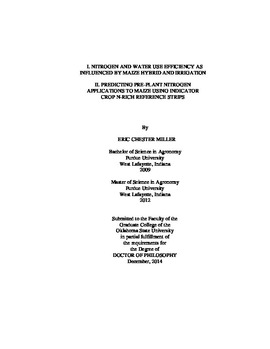I. Nitrogen and water use efficiency as influenced by maize hybrid and irrigation
II. Predicting pre-plant nitrogen applications to maize using indicator crop n-rich reference strips
| dc.contributor.advisor | Raun, William | |
| dc.contributor.author | Miller, Eric Chester | |
| dc.date.accessioned | 2016-01-20T15:44:45Z | |
| dc.date.available | 2016-01-20T15:44:45Z | |
| dc.date.issued | 2014-12 | |
| dc.identifier.uri | https://hdl.handle.net/11244/25687 | |
| dc.description.abstract | Agriculture is an industry with continuous advancements in technology and strategies to increase production while improving efficiency. Hard red winter wheat is a staple crop for many producers in Oklahoma. However, a dramatic increase in the commodity price of maize at the beginning of 2011 resulted in a restored interest to raise maize in the less productive, semi-arid environment of Oklahoma. Provided in this dissertation are two projects that investigate the use of technology and nitrogen fertilizer management strategies to produce maize in Oklahoma. Seed companies have recently commercialized maize hybrids which are marketed as having improved drought tolerance. Both transgenic and non-transgenic approaches have been taken to exploit improved drought tolerance in maize. In chapter one, transgenic and non-transgenic maize hybrids are compared to less drought tolerant maize hybrids. Evaluation of these hybrids grown under irrigation and with different nitrogen (N) fertilizer rates on grain yield, water use efficiency (WUE), and nitrogen use efficiency were investigated. Even with the presence of irrigation and above average rainfall, drought tolerant hybrids offer improved grain yield and WUE. The transgenic drought tolerant hybrid seemed better suited for hot and dry environments. Maize producers should consider incorporating transgenic drought tolerant maize hybrid technology into water stressed farming environments. In chapter two, winter wheat and spring barley indicator crops were used to estimate the N response of the subsequent maize crop. In-season response of the indicator crops was determined (RINDVI) and provided input values to calculate N fertilizer recommendations of the subsequent maize crop using the generalized algorithm. The agronomic optimum N rate (AONR) and response of N fertilizer at harvest (RIHarvest) were calculated from a maize N response trial. Strong correlations existed between the N fertilizer recommendation generated from the generalized algorithm and the AONR for the maize along with the RINDVI for wheat and barley and RIHarvest for the maize. The use of indicator crops to predict the response of a maize crop to N fertilizer is unprecedented and modifications to current maize N fertilizer recommendations could modernize N management strategies for all producers. | |
| dc.format | application/pdf | |
| dc.language | en_US | |
| dc.rights | Copyright is held by the author who has granted the Oklahoma State University Library the non-exclusive right to share this material in its institutional repository. Contact Digital Library Services at lib-dls@okstate.edu or 405-744-9161 for the permission policy on the use, reproduction or distribution of this material. | |
| dc.title | I. Nitrogen and water use efficiency as influenced by maize hybrid and irrigation | |
| dc.title | II. Predicting pre-plant nitrogen applications to maize using indicator crop n-rich reference strips | |
| dc.contributor.committeeMember | Klatt, A. R. | |
| dc.contributor.committeeMember | Arnall, Daryl Brian | |
| dc.contributor.committeeMember | Taylor, Randal K. | |
| osu.filename | Miller_okstate_0664D_13668.pdf | |
| osu.accesstype | Open Access | |
| dc.type.genre | Dissertation | |
| dc.type.material | Text | |
| thesis.degree.discipline | Soil Science | |
| thesis.degree.grantor | Oklahoma State University |
Files in this item
This item appears in the following Collection(s)
-
OSU Dissertations [11222]
